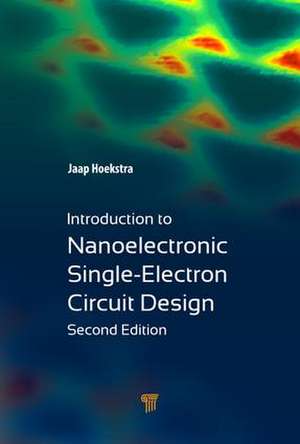Introduction to Nanoelectronic Single-Electron Circuit Design
Autor Jaap Hoekstraen Limba Engleză Hardback – 6 oct 2016
Only book modeling both single-electron tunneling and many electron tunneling from the points of view of electronics; starting from experiments, via a physics description, working towards a circuit description; and based on energy conservation, in electrical circuits, developing the impulse circuit model for single-electron tunneling.
Preț: 482.21 lei
Preț vechi: 621.83 lei
-22% Nou
Puncte Express: 723
Preț estimativ în valută:
92.28€ • 95.80$ • 76.95£
92.28€ • 95.80$ • 76.95£
Comandă specială
Livrare economică 01-15 martie
Doresc să fiu notificat când acest titlu va fi disponibil:
Se trimite...
Preluare comenzi: 021 569.72.76
Specificații
ISBN-13: 9789814745567
ISBN-10: 9814745561
Pagini: 348
Ilustrații: 154 black & white illustrations
Dimensiuni: 152 x 229 x 24 mm
Greutate: 0.59 kg
Ediția:2 Rev ed.
Editura: Jenny Stanford Publishing
Colecția Jenny Stanford Publishing
ISBN-10: 9814745561
Pagini: 348
Ilustrații: 154 black & white illustrations
Dimensiuni: 152 x 229 x 24 mm
Greutate: 0.59 kg
Ediția:2 Rev ed.
Editura: Jenny Stanford Publishing
Colecția Jenny Stanford Publishing
Public țintă
Academic and PostgraduateCuprins
Introduction. Tunneling Experiments in Nanoelectronics. Current in Electrodynamics and Circuit Theory. Free Electrons in Quantum Mechanics. Current and Tunnel Current in Quantum Physics. Energy in Circuit Theory. Energy in the Switched Two-Capacitor Circuit. Impulse Circuit Model for Single-Electron Tunneling—Zero Tunneling Time. Impulse Circuit Model for Single-Electron Tunneling—Nonzero Tunneling Times. Generalizing the Theory to Multi-Junction Circuits. Single-Electron Tunneling Circuit Examples. Circuit Design Methodologies. More Potential Applications and Challenges.
Notă biografică
Jaap Hoekstra obtained an MSc in physics from the University of Amsterdam in 1983 and a PhD in microelectronics from the Delft University of Technology in 1988. Since then he has been employed by the Faculty of Electrical Engineering, Mathematics and Computer Science of the Delft University of Technology to teach semiconductor physics, electronics, and nanoelectronics. Prof. Hoekstra’s research focuses on bit-level systolic arrays, artificial neural networks, microelectronic devices, and nanoelectronics, especially modeling of single-electron devices.
Descriere
Today, the concepts of single-electron tunneling (SET) are used to understand and model single-atom and single-molecule nanoelectronics. The characteristics of nanoelectronic devices, especially SET transistors, can be understood on the basis of the physics of nanoelectronic devices and circuit models. A circuit theory approach is necessary for considering possible integration with current microelectronic circuitry. To explain the properties and possibilities of SET devices, this book follows an approach to modeling these devices using electronic circuit theory.
